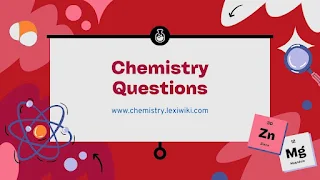Questions about Hydrocarbons (Organic Chemistry)
20 multiple-choice questions about Hydrocarbons (Organic Chemistry), each with five alternatives (A–E). At the end, you will find the answer key with extended explanations.
-- Ads --
Hydrocarbons – Multiple Choice Questions
1. Which of the following is a hydrocarbon?
A) H₂O
B) CH₄
C) CO₂
D) NH₃
E) HCl
2. What are hydrocarbons composed of?
A) Only hydrogen and nitrogen
B) Only carbon and oxygen
C) Only carbon and hydrogen
D) Carbon, hydrogen, and sulfur
E) Carbon and chlorine
3. What is the general formula for alkanes?
A) CnH2n
B) CnH2n+2
C) CnH2n−2
D) CnH2nO
E) CnHn+1
4. Which hydrocarbon series contains at least one carbon–carbon double bond?
A) Alkanes
B) Alkynes
C) Alkenes
D) Aromatics
E) Alcohols
5. What is the simplest alkyne?
A) Methane
B) Ethene
C) Ethyne
D) Propane
E) Butene
6. Which of the following is an unsaturated hydrocarbon?
A) Methane
B) Ethane
C) Propane
D) Ethene
E) Butane
7. What type of bond is found in alkanes?
A) Double bonds only
B) Triple bonds only
C) Single covalent bonds
D) Ionic bonds
E) Metallic bonds
8. Which hydrocarbon has the molecular formula C3H8?
A) Propene
B) Propane
C) Propyne
D) Butane
E) Methane
9. What is the IUPAC name for C₂H₄?
A) Ethyne
B) Ethanol
C) Ethene
D) Ethane
E) Methene
10. Benzene is classified as which type of hydrocarbon?
A) Alkane
B) Alkyne
C) Aromatic
D) Alcohol
E) Ketone
11. Which characteristic applies to aromatic hydrocarbons?
A) Contain straight carbon chains
B) Only have triple bonds
C) Contain a ring with alternating double bonds
D) Are saturated compounds
E) Are always branched
12. What is a common use of hydrocarbons?
A) Glass manufacturing
B) Fuel and energy production
C) Making fertilizers
D) Battery creation
E) Textile dyeing
13. Which compound is a saturated hydrocarbon?
A) Ethene
B) Ethyne
C) Propane
D) Benzene
E) Butene
14. What happens in a combustion reaction of a hydrocarbon?
A) Water is produced only
B) Hydrogen is formed
C) Carbon dioxide and water are produced
D) Only carbon is released
E) Oxygen is reduced to nitrogen
15. Which of the following hydrocarbons is gaseous at room temperature?
A) Octane
B) Butane
C) Hexane
D) Nonane
E) Dodecane
16. Which hydrocarbon is commonly found in natural gas?
A) Ethyne
B) Propane
C) Methane
D) Butane
E) Benzene
17. Which hydrocarbon has a triple bond in its structure?
A) Ethane
B) Ethene
C) Propyne
D) Butene
E) Cyclohexane
18. Hydrocarbons that have the same molecular formula but different structures are called:
A) Isomers
B) Polymers
C) Ions
D) Isotopes
E) Allotropes
19. What type of reaction breaks a hydrocarbon chain using water?
A) Substitution
B) Addition
C) Hydrolysis
D) Combustion
E) Polymerization
20. What is the primary reason hydrocarbons are good fuels?
A) They contain nitrogen
B) They are nonpolar
C) They release large amounts of energy when burned
D) They are solid at room temperature
E) They dissolve in water
✅ Answer Key with Extended Explanations
1. B – CH₄ (methane) is the simplest hydrocarbon, composed of only carbon and hydrogen.
2. C – Hydrocarbons are molecules made of carbon and hydrogen atoms only.
3. B – The general formula for alkanes is CnH2n+2 (saturated hydrocarbons).
4. C – Alkenes have at least one double bond between carbon atoms.
5. C – Ethyne (C₂H₂) is the simplest alkyne, with a triple bond.
6. D – Ethene (C₂H₄) is an unsaturated hydrocarbon with a double bond.
7. C – Alkanes have only single covalent bonds between carbon atoms.
8. B – C3H8 is the molecular formula for propane, a saturated hydrocarbon.
9. C – C₂H₄ is ethene, an alkene with a double bond.
10. C – Benzene is an aromatic hydrocarbon with a ring of alternating double bonds.
11. C – Aromatic compounds like benzene have cyclic structures with resonance (alternating double bonds).
12. B – Hydrocarbons are primarily used as fuels (gasoline, natural gas, etc.).
13. C – Propane (C3H8) is a saturated hydrocarbon (alkane).
14. C – Complete combustion of hydrocarbons produces CO₂ and H₂O.
15. B – Butane (C₄H₁₀) is a gas at room temperature.
16. C – Methane (CH₄) is the main component of natural gas.
17. C – Propyne (C₃H₄) is an alkyne, containing a triple bond.
18. A – Isomers have the same formula but different structural arrangements.
19. C – Hydrolysis breaks down molecules using water, though rare in hydrocarbons unless functional groups are present.
20. C – Hydrocarbons release a large amount of energy due to the combustion of C-H bonds.
Dive into the groundbreaking science of neurotransmitters—your brain’s invisible architects—in Chemical Harmony: How Neurotransmitters Shape Our Lives (2025). This meticulously researched book reveals how serotonin, dopamine, GABA, and other brain chemicals silently orchestrate every aspect of your existence, from decision-making and relationships to mental health and emotional resilience.Click here to buy
Share Online!

